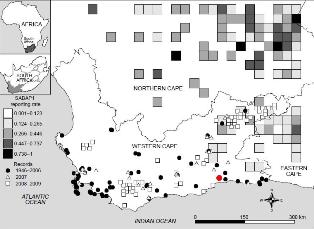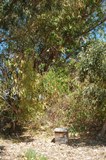PAPER: Range changes 2011-02-22 (96)
Hockey PAR, Sirami C, Ridley AR, Midgley GF, Babiker HA, 2011. Interrogating recent range changes in South African birds: confounding signals from land use and climate change present a challenge for attribution. Diversity and Distribution 17:254-261
Abstract. Aim Apparent anthropogenic warming has been underway in South Africa for several decades, a period over which significant range shifts have been observed in some indigenous bird species. We asked whether these range shifts by birds are clearly consistent with either climate change or land use change being the primary driver.
Location South Africa.
Methods We categorized recent range changes among 408 South African terrestrial bird species and, using generalized linear mixed models, analysed ecological attributes of those species that have and have not changed their ranges.
Results Fifty-six of the 408 taxa studied have undergone significant range shifts. Most extended their ranges towards the south (towards cooler latitudes, consistent with climate-change drivers) or west (towards drier and warmer habitats, inconsistent with climate drivers but consistent with land use drivers); very few moved east or north. Both southward and westward movers were habitat generalists. Furthermore, southward movers were mobile taxa (migrants and nomads), whereas westward movers were associated with human-modified elements in the landscape, such as croplands, plantations or buildings.
Main conclusions The results suggest that both land use changes and climate change may simultaneously be influencing dynamic range shifts by South African birds, but separating the relative strengths of these two drivers is challenging, not least because both are operating concurrently and may influence some species simultaneously. Those species that respond to land use change by contracting their ranges are likely to be among the species that will be most impacted by climate change if land use practices with negative impacts are occurring in areas anticipated to become climatic refugia for these species. This highlights a pressing need to develop dynamic models of species’ potential range shifts and changing abundances that incorporate population and dispersal processes, as well as ecological processes that influence habitat suitability.

Between the 1970s and the 1990s three weaver species underwent shifts in their southward range limits (White-browed Sparrow-Weaver,
Sociable Weaver and Scaly-feathered Finch) while two weaver species underwent shifts in their westward range limits (Thick-billed Weaver and Red-billed Quelea). Read more here about the quelea range expansion (also map on right).
Literature as featured in Weaver Watch news items
|











